From Shinjuku Station, we took the JR line to Tokyo Station. In Tokyo Station, we bought boxed meals from one of the many stalls before hurrying to find the right platform for the Hakutaka train on the Hokuriku Line (the shinkansen line that connects Tokyo and Kanazawa).
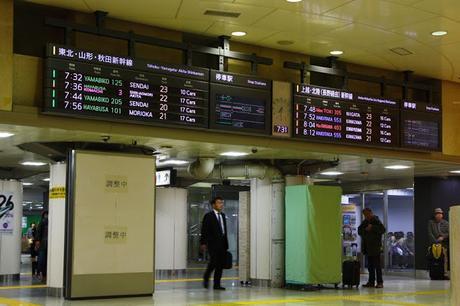 Tokyo JR Station
Tokyo JR Station The Hakutaka has arrived (at Shin-Takaoka Station)
The Hakutaka has arrived (at Shin-Takaoka Station)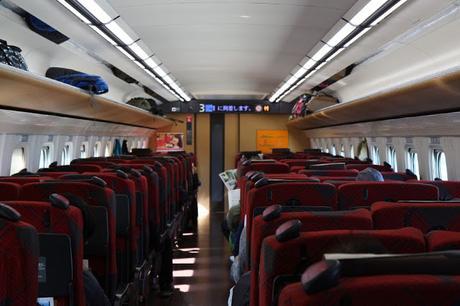 3 hours from Tokyo to Shin-Takaoka
3 hours from Tokyo to Shin-Takaoka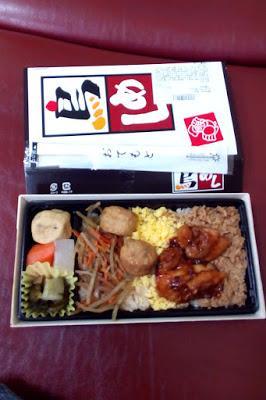 Breakfast on the go: ekiben (boxed meal bought at one of the stalls in Tokyo Station, 850 yen)
Breakfast on the go: ekiben (boxed meal bought at one of the stalls in Tokyo Station, 850 yen)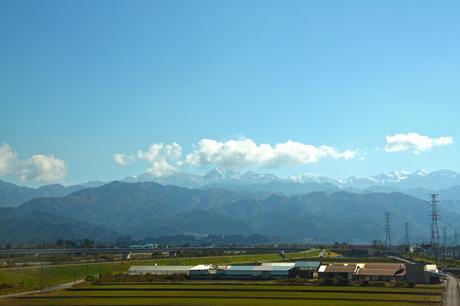 On the way to Shin-Takaoka: the urban skyline gave way to the rolling countryside
On the way to Shin-Takaoka: the urban skyline gave way to the rolling countrysideAt 260 kph, the scenery zoomed from an urban jungle to mountains and green fields and soon our stop (Shin-Takaoka Station) was announced and our three-hour shinkansen ride was over. Before proceeding to the bus stop just outside Shin-Takaoka station, we dropped by the tourist information desk to ask for the bus schedule and to ask where the coin lockers were. Since we were staying just a night at Ainokura, we left our bags in coin lockers and just brought what was necessary for a one-night stay.
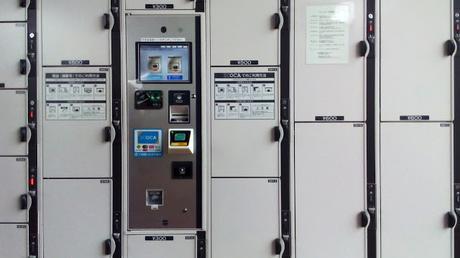 Coin lockers
Coin lockers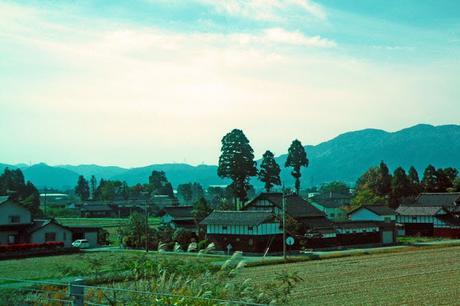 Countryside views on the way to Ainokura
Countryside views on the way to AinokuraThe one-hour bus ride didn't seem long at all. We were dropped off on the side of the road and the bus driver pointed to a path off to the side of a deserted parking lot. It was a pleasant 5-minute walk along a narrow tree-lined and leaf-strewn 300-meter path. And then the path gave way to wide open space and our eyes beheld a wondrous rural landscape: some twenty farmhouses with tall A-shaped thatch roofs (gassho-zukuri or gassho-style, like hands pressed together in prayer) embraced by mountains all ablaze in warm autumn colors. Ah, it was love at first sight.
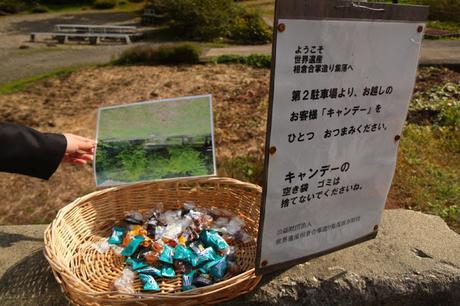 Welcome candy!
Welcome candy!We replaced our hanging lower jaws and peeled our eyes off the scenery. That's when we spotted a basket of candies by the side of the road with a sign in Japanese which we took to mean as "welcome to Ainokura, please get a candy" (yes, I happily got a candy). We moved away from the free candy basket and focused on finding Goyomon, the minshuku (family run bed and breakfast) that we had booked through the Japanese Guesthouses website.
We found our house, thanks to the wooden sign outside: 五ヨ門, which we knew to mean as Goyomon. We knocked on the door, but there was no answer. We tried the door, it was unlocked, and we gingerly walked into the genkan (entryway, usually recessed or lower than the main house) calling out sumimasen (すみませんexcuse me) until a motherly figure appeared from the kitchen wiping her hands on her apron. She welcomed us in her limited English while we struggled to get out of our shoes and slip into the house slippers waiting on a wooden shelf off to the side of the genkan. She led us across a tatami room (where we had to remove our house slippers) then opened the sliding door to our room: a bare tatami room with sliding doors on all sides, and on the corner, a basket of neatly folded yukata (a robe, or a casual version of a kimono). In a few strides we walked the perimeter of our room as a way of inspection and dumped our bags in the farthest corner, then tailed her out the room, crossed the tatami room, slipped our house slippers on, then continued through the wood-floored hallway, leading us to a table in the back where she then brought us a pot of matcha (green tea) and biscuits with a drawing of a gassho-style house.
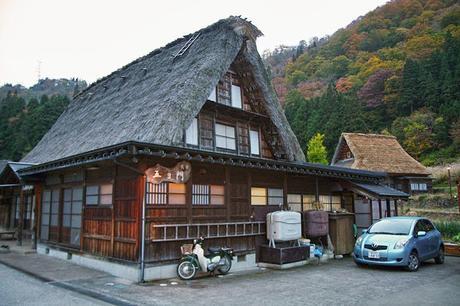 Goyomon, our home for the night
Goyomon, our home for the night Welcome snack: biscuit and tea
Welcome snack: biscuit and teaWe took our time nibbling and sipping our welcome biscuit and tea. Curious if there was a garden out back, I opened the shoji (wooden sliding door with translucent paper), letting in the chilly mountain air and unfolding a scene that made me immediately thank God that we were brought to this corner of Japan.
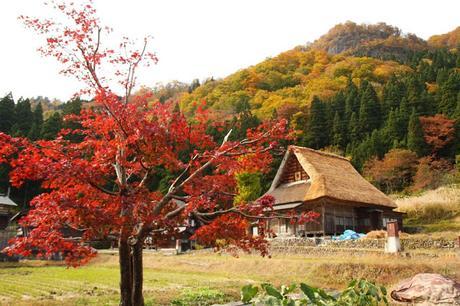 Thank you God
Thank you GodWe spent the day walking around Ainokura, hiking to the viewpoint, admiring the houses and the backdrop of mountains awash with the colors of autumn, and rubbing our hands to keep the autumn chill away. We ate lunch at Matsuya, a restaurant, souvenir shop, and convenience store all crammed under one gassho-style roof. (There are only two dining options in Ainokura.) There were a handful of Japanese day trippers doing the same things we did.
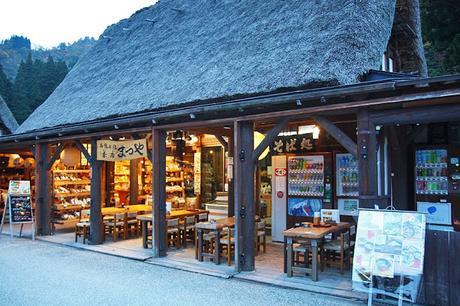 Matsuya, a souvenir shop, convenience store, and restaurant all rolled into one
Matsuya, a souvenir shop, convenience store, and restaurant all rolled into one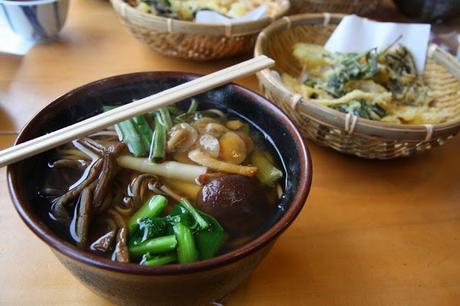 Sansai Soba (soba with wild vegetables, 950 yen) at Matsuya
Sansai Soba (soba with wild vegetables, 950 yen) at Matsuya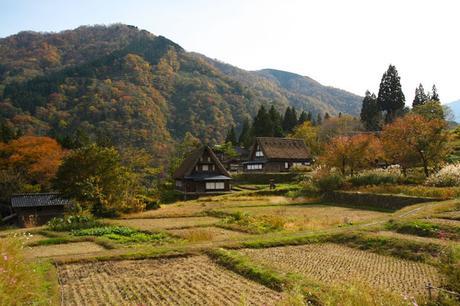
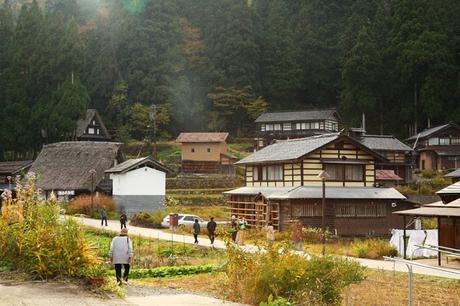
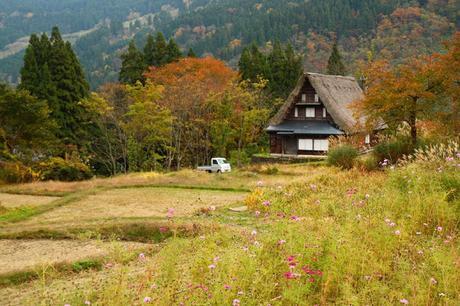
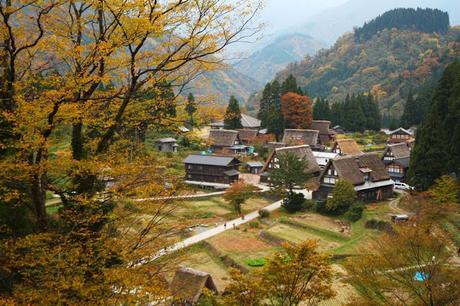 Ainokura from the viewpoint
Ainokura from the viewpointAinokura is a small village but we managed to spend all our time outside. Only when it started to get dark and all the day trippers had left and there were no other tourists but us did we decide to call it a day and head back to Goyomon, where we found our room already laid out with warm futon.
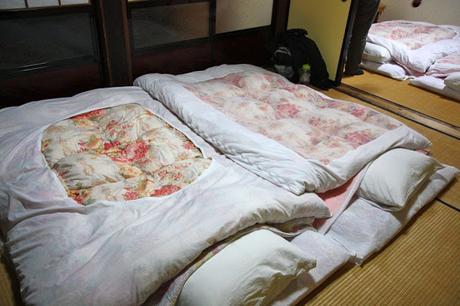 Futon
FutonMy friends and I rejoiced when we found we were the only guests that night and more rejoicing when we found out that Goyomon had a private ofuro (a Japanese bath). We were afraid we'd have to go to a sento (public bath house) because we were told, when we made the booking, that Goyomon didn't have a private bath. In the ofuro was a low tap with a detachable shower head, bottles of shampoo and bath gel (all labeled in Japanese syllabic script or kana), a low plastic stool in front of the tap, and a bath tub of hot water. I was the last to use the ofuro and I knew (hoped) my friends were smart enough to soap, shampoo, and rinse before soaking in the tub!
My hair was still dripping and my yukata askew when we were called to have dinner. In the tatami room just outside our bedroom, zabuton (thin pillows for sitting on) and small tables with a delicious looking dinner was already set up around the irori (sunken hearth used to cook food and heat the room). Joining us for dinner were the couple who owned Goyomon and their friends, three grannies aged 66, 83, and 96.
 Home-cooked dinner!
Home-cooked dinner!The home-cooked dinner was so good that I ate everything that was served and had to loosen my yukata's sash. The host's 66-year-old friend who was drinking some kind of Japanese liquor offered us drinks but we declined. After dinner, our host showed us a video of her daughter performing and playing a traditional wooden musical instrument called a sasara (made up of 108 wooden slats joined together by rope). When the performance ended, she brought out two sasara and two sets of wooden sticks (I don't know what these sticks are called) and taught us how to use these traditional Japanese percussion instruments. When she deemed our musical skills satisfactory, she sang the oldest folk song in Japan entitled Kokiriku-bushi, but in a faster pace and a livelier manner, and we laughingly fumbled with our instruments as we tried to keep up with her singing.
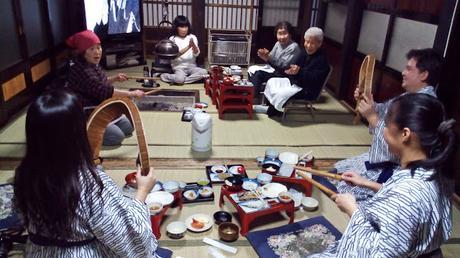 Playing a Japanese folk song with cute grannies as our audience
Playing a Japanese folk song with cute grannies as our audienceThe night went on with conversations in two languages: us in English, them in Japanese. We bridged this gap by treating our conversations like we were playing charades. It was a night filled with laughter and it went by quickly. Soon it was time to retire to bed, and before doing so I went to the washroom to brush my teeth. Midbrush 66-year-old drunk grandma walked in gave me a hug! (I guess she found my roundness and fluffiness irresistible! Haha!) I hugged her back and through the bubbly toothpaste in my mouth bade her oyasumi nasai (おやすみなさい good night).
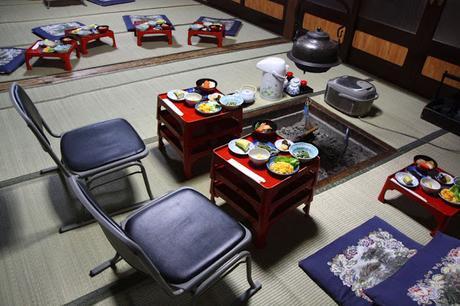 Breakfast is ready
Breakfast is readyBreakfast was already waiting when we woke up. Mealtime this time was quiet and behaved (with grandma already sober). We only had three hours left in Ainokura and before we had to leave for our next destination, we went to Ainokura's museums: Ainokura Folklore Museum and Ainokura Traditional Industry Museum (350 yen for the combination ticket). The Folklore Museum showcases life in Gokayama region with displays of tools and other things used in daily life. It also has information on how gassho-zukuri houses are built (and why they are built that way). The Traditional Industry Museum tells about the industries of Gokayama such as making washi paper and silk (sericulture).
It would have been nice to try our hand at making washi at Gokayama Washi, but our time was up: we had to catch the bus back to Shin-Takaoka Station and then take the 3-hour 2-train ride to our next destination: Kyoto.
Accommodations in Ainokura: There are six minshuku in Ainokura and an overnight stay (with dinner and breakfast) ranges from 8800 yen to 15000 yen per person. We stayed in Goyomon and it set us back 8800 yen each. It was the most expensive accommodation I have ever spent on but the experience was well worth every yen I had to coax out of my pocket! If time and money had permitted, I would have loved to have stayed one more night.
Directions from Tokyo to Ainokura: Take the Hokuriku shinkansen from Tokyo Station to Shin-Takaoka Station (3 hours; fare is at least 13000 yen). At Shin-Takaoka Station, take the bus headed for Shirakawago, but alight at Ainokura-guchi bus stop. The bus ride takes an hour and will cost 1000 yen. Note that buses from Shin-Takaoka go to Shirakawago five times a day only.
UNESCO World Heritage Site: There are three historic Japanese villages included in the UNESCO World Heritage Site list: Ogimachi in Shirakawago in Gifu Prefecture, the largest (59 houses) and the most popular, and the two smaller villages in Gokayama in Toyama Prefecture: Ainokura (23 houses) and Suganuma (9 houses). These villages are not open-air museums but are real villages where people live. When visiting these villages, please keep in mind to behave and keep voices down.
JapanKnow Before You Go
Single Entry Tourist Visa for Japan
Roam Around Japan with a Swagger
From Tokyo to Hiroshima (2015)
10D/9N | Tokyo, Toyama, Kyoto, Hyogo, Osaka, Hiroshima
Tokyo: Shinjuku Airbnb
Tokyo: Memorable Tokyo Eats
Tokyo: Odaiba
Tokyo: Doing Touristy Things in Tokyo
Toyama: A Night to Remember in Ainokura (you're here!)
Kyoto, Hyogo, Hiroshima, Osaka (soon)
Concentrate on Kansai (2016)
(soon!)

